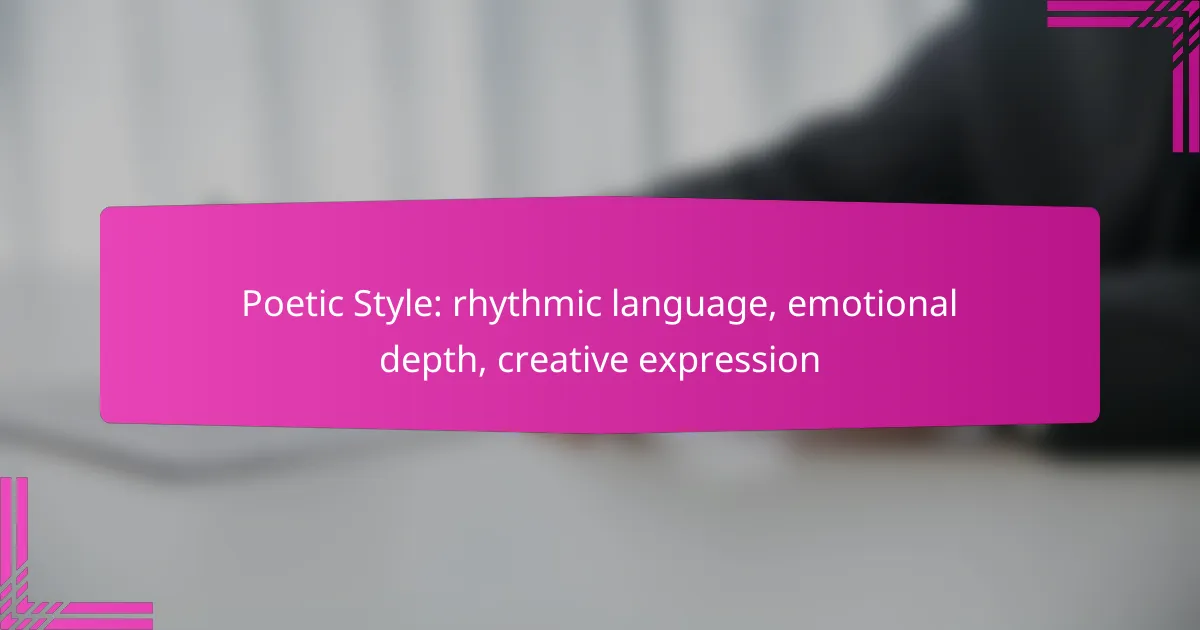In screenwriting, crafting engaging dialogue is crucial for character development and plot progression, as it reveals emotions and creates conflict while maintaining authenticity. Complementing this, effective visual storytelling enhances the narrative by conveying emotions through imagery, allowing for a more immersive audience experience. Ultimately, developing multi-dimensional characters requires a deep understanding of their backgrounds and motivations, which propels the story forward.

How to write engaging dialogue in screenplays?
Engaging dialogue in screenplays is essential for character development and advancing the plot. It should reveal emotions, reflect character voice, and create conflict while sounding natural and authentic.
Use subtext to convey emotions
Subtext refers to the underlying meaning beneath the spoken words. Characters may say one thing while feeling another, allowing for deeper emotional resonance. For example, a character might say “I’m fine” while their body language and tone suggest otherwise, creating tension and intrigue.
To effectively use subtext, consider the emotional stakes of the scene. What is the character really trying to communicate? This approach can lead to more layered interactions that engage the audience.
Incorporate character voice and tone
Each character should have a distinct voice and tone that reflects their background, personality, and current emotional state. This differentiation helps the audience connect with characters on a personal level. For instance, a sarcastic character might use humor to mask vulnerability, while a more serious character may speak in a straightforward manner.
To develop unique voices, consider their life experiences, education, and social environment. Writing dialogue that feels authentic to each character enhances believability and keeps the audience invested.
Utilize conflict to drive conversations
Conflict is a powerful tool in dialogue, as it propels the narrative forward and reveals character dynamics. Conversations should reflect tension, disagreement, or differing goals to create engaging exchanges. For example, a heated argument can reveal deep-seated issues between characters.
When crafting dialogue, think about what each character wants and how their desires conflict with one another. This approach not only adds drama but also enriches character development.
Employ realistic speech patterns
Realistic speech patterns enhance the authenticity of dialogue. People often use incomplete sentences, interruptions, and colloquialisms in everyday conversations. Mimicking these patterns can make dialogue feel more genuine.
To achieve this, listen to how people speak in real life. Pay attention to pacing, pauses, and the use of slang or regional dialects. This attention to detail can significantly improve the quality of your screenplay’s dialogue.
Analyze successful films for examples
Studying successful films can provide valuable insights into effective dialogue writing. Pay attention to how characters interact, the use of subtext, and the pacing of conversations. Films like “Pulp Fiction” or “The Social Network” showcase sharp, engaging dialogue that drives the story.
Take notes on specific scenes that resonate with you. Analyze what makes the dialogue effective and consider how you can apply similar techniques in your writing. This practice can help you refine your own dialogue skills.

What techniques enhance visual storytelling?
Techniques that enhance visual storytelling focus on conveying emotions and narratives through imagery rather than dialogue. By utilizing visual elements effectively, screenwriters can create a more immersive experience for the audience.
Show, don’t tell through imagery
Showing rather than telling is fundamental in visual storytelling. Instead of relying on dialogue to convey emotions or plot points, use imagery that illustrates these elements. For example, a character’s loneliness can be depicted through a wide shot of them sitting alone in a crowded room.
To implement this, consider the environment, body language, and facial expressions of characters. These visual cues can communicate complex feelings without a single word being spoken.
Use visual metaphors to deepen themes
Visual metaphors can enrich the narrative by representing themes symbolically. For instance, a wilting flower might symbolize a character’s declining hope. This technique allows audiences to engage with the story on a deeper level, prompting them to think critically about the underlying messages.
When crafting visual metaphors, ensure they are relevant to the story and resonate with the audience. Subtlety is key; the metaphor should enhance the narrative without overwhelming it.
Incorporate dynamic camera angles
Dynamic camera angles can significantly impact how a story is perceived. Low angles can make a character appear powerful, while high angles can suggest vulnerability. By varying camera perspectives, you can create tension, emphasize emotions, or highlight important details.
Experiment with different angles during key scenes to see how they alter the audience’s perception. For example, a close-up shot can intensify a moment of realization, drawing viewers into the character’s experience.
Implement color palettes for mood
Color palettes play a crucial role in setting the mood of a scene. Warm colors like reds and oranges can evoke feelings of passion or anger, while cool colors like blues and greens often suggest calmness or sadness. Choosing the right palette helps to visually communicate the emotional tone of the story.
When selecting a color scheme, consider the overall theme and character arcs. Consistency in color usage throughout the film can reinforce emotional connections and enhance storytelling. For instance, a gradual shift from bright colors to muted tones can reflect a character’s journey from happiness to despair.

How to develop compelling characters?
Developing compelling characters involves creating multi-dimensional individuals that audiences can connect with emotionally. This process requires a deep understanding of their backgrounds, motivations, and relationships, which ultimately drives the narrative forward.
Create detailed character backstories
Character backstories provide essential context that shapes a character’s motivations and behaviors. A well-crafted backstory can include details about their upbringing, significant life events, and personal challenges. For example, a character who grew up in a troubled household may exhibit trust issues or a desire for stability.
To create effective backstories, consider using a character questionnaire that explores their childhood, education, and pivotal moments. This can help you build a rich tapestry of experiences that inform their actions and decisions throughout the story.
Establish clear character arcs
A character arc is the transformation a character undergoes throughout the story, often reflecting their internal struggles and growth. Establishing a clear arc helps audiences invest in the character’s journey. For instance, a character who starts as selfish may evolve into a selfless hero by the end.
When crafting character arcs, identify key turning points that challenge your character and prompt change. Aim for a balance between obstacles and achievements to create a satisfying progression that resonates with viewers.
Use relationships to reveal traits
Relationships are a powerful tool for revealing character traits and driving development. Interactions with other characters can highlight strengths, weaknesses, and complexities. For example, a character’s kindness may shine through in their interactions with a vulnerable friend.
To effectively use relationships, create dynamic pairings that challenge or complement your characters. Consider how different relationships—such as friendships, rivalries, or familial bonds—can expose various facets of a character’s personality.
Incorporate flaws for relatability
Flaws make characters relatable and realistic, allowing audiences to see parts of themselves in them. A character with a fear of failure or a tendency to be overly critical can evoke empathy and connection. These imperfections can drive conflict and create opportunities for growth.
When incorporating flaws, ensure they are balanced with redeeming qualities. This complexity makes characters more engaging and allows for meaningful development throughout the narrative. Aim for flaws that challenge the character and contribute to their overall journey.

What are the prerequisites for effective screenwriting?
Effective screenwriting requires a solid grasp of screenplay structure, genre conventions, and character development. These elements help create engaging dialogue and visual storytelling that resonate with audiences.
Understand screenplay structure
Screenplay structure is the framework that guides the narrative flow of a script. Familiarize yourself with the three-act structure, which typically includes setup, confrontation, and resolution, allowing for a clear progression of events.
Each act serves a specific purpose: the first act introduces characters and conflicts, the second act escalates tension, and the third act resolves the story. Consider using plot points to mark transitions between acts, ensuring a cohesive narrative.
As you write, keep in mind the importance of pacing. Aim for a balance between dialogue and action, with scenes that drive the plot forward while allowing for character development.
Familiarize with genre conventions
Understanding genre conventions is crucial for effective screenwriting, as each genre has its own set of expectations. Familiarize yourself with the characteristics of genres such as drama, comedy, horror, and thriller to create a script that aligns with audience expectations.
For example, a romantic comedy often includes elements like meet-cutes and misunderstandings, while a thriller relies on suspense and unexpected twists. Incorporating these conventions can enhance the appeal of your screenplay.
Be cautious, however, not to fall into clichés. Strive for originality within the framework of genre conventions, allowing your unique voice to shine through while still meeting audience expectations.

How to choose the right screenwriting tools?
Selecting the right screenwriting tools involves assessing your specific needs, such as formatting requirements, collaboration capabilities, and budget. Popular software options offer various features that cater to different aspects of the screenwriting process, from dialogue to visual storytelling.
Evaluate software like Final Draft
Final Draft is a leading screenwriting software known for its industry-standard formatting and robust features. It streamlines the writing process with tools for organizing scenes, characters, and dialogue, making it easier to focus on storytelling.
When evaluating Final Draft, consider its price point, which typically ranges from around $200 to $250. Weigh the benefits of its advanced features, such as real-time collaboration and extensive templates, against your budget and writing style.
Consider collaboration features in Celtx
Celtx is a versatile screenwriting tool that emphasizes collaboration, making it suitable for teams. It offers cloud-based access, allowing multiple users to work on a script simultaneously, which can enhance the creative process.
When considering Celtx, look at its pricing model, which often includes a subscription fee that can be more affordable than one-time purchases. Evaluate whether its collaboration features, such as commenting and version tracking, align with your project needs and team dynamics.



